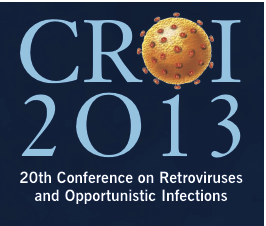Optimising ART initiation in pregnancy through linkage of services vs integration of ART into antenatal care
29 May 2013. Related: Conference reports, Antiretrovirals, Pregnancy, CROI 20 (Retrovirus) 2013.
 Polly Clayden, HIV i-Base
Polly Clayden, HIV i-Base
The separation of antenatal care (ANC) and ART services can be an obstacle to starting ART in pregnancy. Interventions to improve antenatal ART services can maximise the proportion of eligible women starting ART in pregnancy and minimise delays in ART initiation. [1]
Landon Myer from the University of Cape Town showed findings at CROI 2013 from a study evaluating two interventions that could potentially improve ART in pregnancy: enhanced linkage (EL) – using lay counsellors as navigators to guide pregnant women from ANC to ART services – vs integration (IN) of ART into ANC services – with screening and initiation performed by midwives without referral as part of routine ANC care.
The study was conducted at s single large ART programme with an adjacent ANC clinic in the township of Gugulethu, Cape Town, South Africa. It used a sequential before/after design to compare outcomes associated with standard of care (SOC) compared to the two interventions: SOC – January to June 2011; EL – July to December 2011; IN – January to June 2012.
Routine public health sector staff implemented the services with weekly monitoring and support from the research team. Eligibility for ART was according to South African guidelines, initiation at CD4 < 350 cells/mm3 and/or WHO stage 3 or 4. Women received efavirenz/tenofovir/3TC. Data were collected describing the proportions of women completing each step in the PMTCT and ART “cascades,” and delays between these.
During the study period 8752 women sought ANC care with 95% uptake of testing, 26% testing HIV positive with 90% CD4 results available. The proportion of eligible women screened for and initiating ART increased significantly from baseline. SOC 26% and 21%; EL 53% and 49% and IN 93% and 86% women were screened and initiated ART respectively, p<0.001 for both comparisons (differences persisted after adjustment for maternal age, gestation, education and CD4 count).
The delay from a positive HIV test in ANC to identification as eligible for ART did not vary, median, 18 days (IQR 16 – 36). But the delays from identification to ART initiation decreased significantly. Median delay: SOC 29 days (IQR 14 – 46); EL -15 days (IQR 9 – 24) and IN 7 days (IQR 5 – 14), p=0.003 for both comparisons.
These operational interventions to strengthen antenatal ART initiation lead to significant increases in the proportion of women starting ART as well as decreases in the delays to ART initiation, Dr Mayer concluded. But, extra interventions are needed to address the delays between HIV testing, identification as ART-eligible, and referral for ART.
comment
The persistent delay from the day of HIV diagnosis, reported in this study and many others, remains an issue. Dr Myer described this phenomenon as “sobering”, remarking, “we want as close to instantaneous initiation and excellent retention.”
A related poster showing cost effectiveness modelling of point of care (POC) testing in ANC found this to be cost effective in South Africa. [2] The investigators reported that compared to “low access” laboratory, POC was cost saving unless the test cost $305 or more, or the proportion of women tested and receiving results was less than 14%. With “high-access” laboratory, POC remained cost saving unless the test cost more than $45 or the proportion of women tested and receiving results was less than 84%. When POC also improved time to ART initiation, there were also clinical benefits. The group intends to look at using POC in the programme to help to shrink the delay.
There were no increased costs with additional staffing in this programme. The EL intervention used lay counsellors, already working in the ANC, and the IN intervention an extra public sector midwife – reduced staffing at the adult ART clinic would offset this cost.
The of numbers of women accessing ART in ANC is likely to increase in South Africa and programmes also have concerns about retention in care post partum.
References:
- Myer et al. Optimisation of ART initiation in pregnancy through linkage of services vs integration of ART into antenatal care. 14th CROI. Atlanta, GA. 3-6 March 2013. Oral abstract 83.
http://www.retroconference.org/2013b/Abstracts/46348.htm
http://webcasts.retroconference.org/console/player/19425?mediaType=audio - Ciaranello A et al. The cost-effectiveness of point-of-care CD4 testing in antenatal care in South Africa. 14th CROI. Atlanta, GA. 3-6 March 2013. Poster abstract 917.
http://www.retroconference.org/2013b/Abstracts/45973.htm

